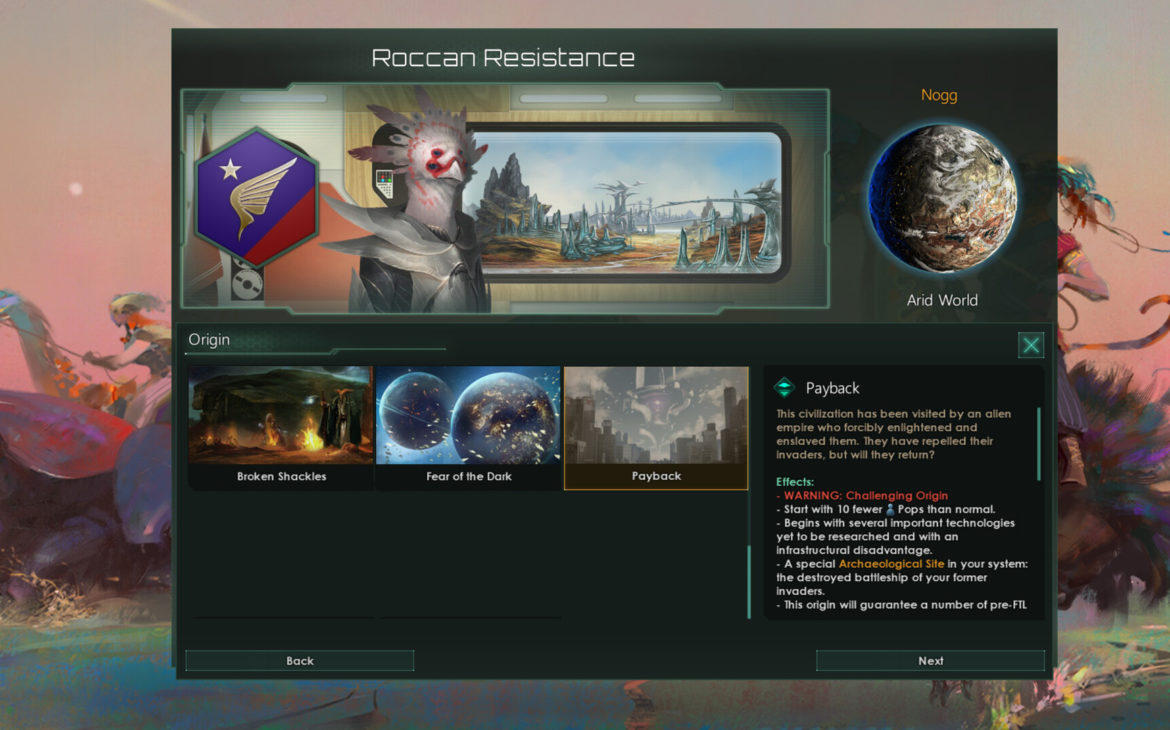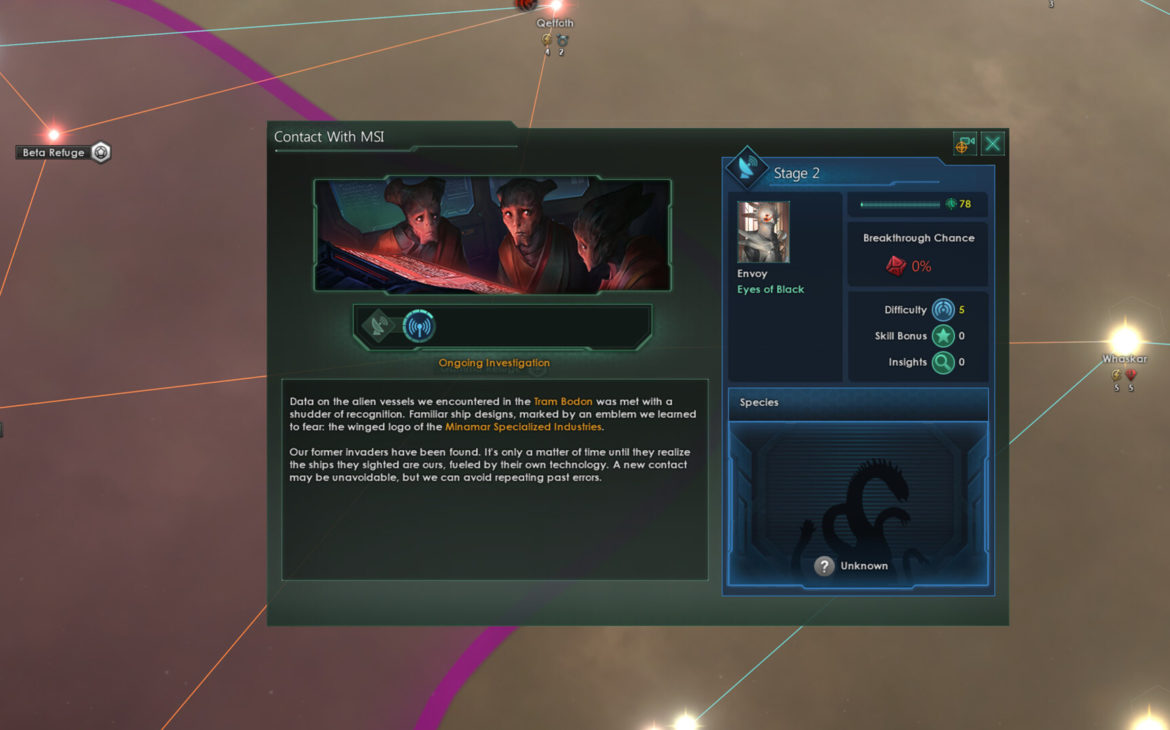Stellaris: First Contact is a new story pack DLC for the 4X sci-fi grand strategy game by Paradox. The focus of this new story pack is on interactions with pre-FTL primitive civilisations and their place in the galaxy, allowing diplomacy and espionage against those civilisation for both benevolent and ulterior motives. In addition, the DLC adds 3 challenging new origins and 4 new civic types for various flavours of factions that you play as. So how does it compare to previous DLC’s?
For those unaware, Stellaris is a sci-fi 4x grand strategy title where you control a nation from its very beginnings on exploring the galaxy, and pilot it through the many trials and tribulations you’ll encounter along the way. You will control the beginning as generally a nation controlling a single planet and its people, all the way through to a galaxy spanning empire that counts many different species amongst its number. You are in control of everything from colonisation to exploration to warfare, and its one of my favourite strategy games of all time. First released in 2016, its had many DLC’s since then that have expanded the game significantly, and First Contact is the latest amongst these.
A Time For Vengeance
The first origin added by Stellaris: First contact is called Payback. In it, you start with a planet that has managed to repulse the invaders of a hostile empire, but they’re still out there and waiting for you. Remnants of the battle litter your planet, and although it will take time to clear these up you’ll get the benefit of additional resources you can utilise. In addition, you will start with an archaeological site on your planet, which when completed gives you a free battleship that you can additionally upgrade over time as you accumulate tech. This is a huge help and will allow the more militaristically minded player to expand early and deal with most enemies you may encounter to begin with. In addition, you will be attacked periodically by debt collectors trying to make you pay reparations for destroying the invaders ships – they’re nothing too crazy to worry about, however, and an astute player can deal with them easily. Next up, the big corporation that invaded your homeworld and enslaved you, MSI, is out there in the galaxy and waiting for you. They want revenge for the losses you inflicted upon them, and they will use war as a tool to achieve that and try to re-subjugate you. Occasionally, they will declare war on you if you’ve destroyed the debt collectors enough times, but they’re generally far enough away that this isn’t too much of a concern and you can generally just agree to a peace with no trading of territory easily.
The Payback origin is challenging as you start with an infrastructure disadvantage compared to most other origins. You’ll have less resource extractors initially built in your home system, and no construction or explorations ships available to begin with. In addition, you will also start with a reduced tech level, and won’t even have access to basic military ships such as corvettes or important buildings like additional research labs until you’ve completed the relevant research. All this means that you’ll start around 10 years or so behind other races you’ll encounter in tech level, but the battleship you can get early will allow you to expand quickly via conquest. The Payback origin also comes with an inherent bonus to damage you inflict on militarily superior enemies, which is a huge buff later in the game against bigger empires and players if you’re playing with multiplayer.

Stronger Together
Broken Shackles is the next origin, and is similarly challenging but in different ways. In Broken Shackles, you start as a bunch of slaves that manged to liberate themselves from the aforementioned MSI by crashing their slave ship into a thankfully habitable planet after overcoming the guards. You’ll start with many different species, which is both a blessing and a curse – they may not suit the planet that you’ve crashed on and won’t be the most productive due to this, but if you have plenty of other planet types around you they can quickly colonise them and allows for rapid expansion. If you can pull if off, this rapid expansion and astute economic management will allow you to become a powerhouse fairly quickly. I think in the hands of a good player, this is probably going to be one of the strongest starts if you’re not one for conquest and prefer to expand peacefully.
Just like Payback, in Broken Shackles you’ll also have reduced infrastructure and tech to begin with. Unlike Payback, as well as the reduced tech and mining structures in your home system, you’ll also start with basic primitive buildings barely enough to scratch a living and keep you colonists fed. Some of these will automatically upgrade over time, such as the research station to a lab once you have the research for them, whilst other such as the command centre will need to be upgraded to a capital via resources as normal. Finally, some buildings will stay primitive unless you manually destroy them and replace them, or complete the archaeological site in your home system once its appeared and then invest further resources into upgrading your home colony. I would say this is the most challenging of the starts, but also one of the most rewarding and it was my favourite to play as overall.
The last origin is Fear of the Dark and it is a little different to the previous two mentioned. Instead of being invaded or enslaved, in the not-too-distant past a planetary body within your home system blew up. A subset of your populace blames aliens from out there for the catastrophe and has turned extremely xenophobic. So xenophobic, in fact, they refuse to cohabit your homeworld and have instead colonised a partially terraformed world within the same system. The start for this origin is a bit more traditional for Stellaris and less challenging, but still has some unique points – the xenophobic colony can demand resources and give tech in return, and if you try to befriend other races you encounter they’ll launch attacks which can help or hinder you, depending on your actions. I feel this was the weakest start in terms of uniqueness and fun, but its nice to have it in here with the DLC.
The Truth Is Out There
The next major selling point of the Stellaris: First Contact DLC is interactions with primitive civilisations. Now, you’ll be able to interact with any pre-FTL civilisations you encounter more thoroughly, conducting diplomacy and espionage with them and being able to access unique insights after studying them for enough time. To interact with these civilisations, you’ll first need to establish an observation post as before and this will provide society research passively as in past Stellaris updates. However, now you have the chance to use your diplomatic envoys to embed agents within their society and shape or bend their society to your will. Your presence can be detected over time via awareness, and if the civ reaches too much awareness they will become fully cognizant of your empire and this will allow additional interactions, such as actively shaping their society to suit your own ethics or allowing a commercial agreement. If you choose to stay as undetected as possible and not disclose yourself (which is easier via the new cloaking technology and mechanics) then you will just continue collecting insights which unlock special techs you can then research for various bonuses, such as additional envoys and research. Overall, this is a nice addition but it does feel a bit limited and considering the DLC is named after a civilisations First Contact with other aliens, I do wish there was a bit more to it.
The final major mechanic added to the DLC is cloaking, which is a much requested and anticipated feature to the game and a staple of sci-fi lore. Cloaking is a new technology that allows you to hide and stealth your ships, whether single ships or entire fleets, and opens many tactical and strategic options for the player, as well as helping with hiding your observation stations as previously mentioned. Over time you’ll be able to unlock cloaking techs via your physics research branch, and they unlock modules for your military ships that can be used to allow a fleet to cloak. To begin with, basic cloaking tech comes with significant downsides to sublight speed within systems and hyper jump charge rate between systems, but more advanced cloaking modules can be research over time and some origins, traditions and ascension perks improve your capabilities to the point these penalties can be eliminated entirely. Cloaking is a really useful feature and can allow for surprise attacks and hit and run raids which opens up the players toolbox immensely, can’t be used permanently as it does have a cooldown, and can be countered by extremely good sensors if a player has researched them. Overall, it is a fun and worthy addition to Stellaris.

We Don’t Need Hyperlanes Where We’re Going
The last addition in Stellaris: First Contact are various new civics you can use which bring additional flavour to your game if you want to use a more traditional empire without using the new origins, and these have an emphasis on exploration. The civics are all similar and are for use by different types of starts, such as a Hive Mind or a Megacorporation, but vary slightly in the buffs they give even if the mechanics are the same. These civics are Eager Explorers, Privatised Exploration, Stargazers and Exploration Protocols (for most empires, Megacorporations, Hive Minds and Machine Intelligences respectively). These civics change your start to be slightly more primitive than normal and have a reduced tech level (similar to the more primitive starts in Broken Shackles and Payback) and you’ll start without hyperdrives but instead be using Jump Drives. This is a bit of a jump back to the launch of the game, when there were 3 different types of FTL systems, and Jump Drives were one of them. You’ll have a small range around the jump drive that you can move to using your ships, and its neat to see it show up once more in the early game of Stellaris. The civic is a nice addition and will combine nicely with the various other origins and civics available in the game and I’m glad they added it in.
Over the course of reviewing this DLC, I did run into a couple of bugs. Pre-FTL civilisation had a habit of wiping themselves out via the horrors of nuclear war on a consistent basis, leaving limited interaction for one of the main parts of the DLC. I also ran into the problem of my population, which I chose to be xenophile and love aliens, all turn to xenophobic and making my start basically impossible at game start whilst testing out a couple of Broken Shackles runs due to my factions rebelling against me.
Overall, Stellaris: First Contact in a tough one for me to judge. There are excellent elements of this DLC, but there are others which need further fleshing out to really bring out the full potential of their mechanics. For hardcore Stellaris fans, there is fun to be had here and the new content is welcome, but it isn’t a must have DLC and can be skipped over if you don’t feel a particular affinity for these new additions to the game.

Stellaris: First Contact is available now on PC via Steam
Developer: Paradox Development Studio, Paradox Arctic
Publisher: Paradox Interactive
Disclaimer: In order to complete this Review, we were provided with a promotional code from the publisher. For our full review policy, please go here.
If you enjoyed this article or any more of our content, please consider our Patreon.
Make sure to follow Finger Guns on our social channels. Twitter, Facebook, Twitch, Spotify or Apple Podcasts – to keep up to date on our news, reviews and features.

COMMENT
OH WOW they brought back the old movement system of Jump (Warp) Drives from game start 🙂
I miss the old Warp, Hyperlanes, and Wormholes – it made for much more dynamic games among players and greater variety for your own empires.
Nice review and it might have sold me on this DLC. I still haven’t bought the last one…